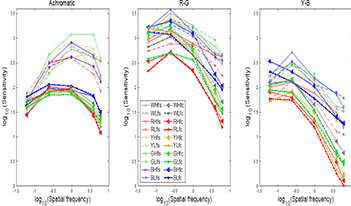
The goals of this work are to accumulate experimental data on contrast sensitivity functions and to establish a visual model that incorporates spatial frequency dependence. In the experimental design, two patterns were compared: fixed-size and fixed-cycle stimuli from different luminance levels. The detection thresholds have been measured for chromatic contrast patterns at different spatial frequencies. The present experiment was conducted with the aim to form a most comprehensive data by combining with our data. The experimental parameters including (1) five colour centres (white, red, yellow, green and blue), which were recommended by the International Commission on Illumination (CIE), at two different luminance levels for each colour centre; (2) three colour directions for each colour centre, namely luminance, red-green and yellow-blue and (3) five spatial frequencies, 0.06, 0.24, 0.96, 3.84 and 6.00 cycles per degree (cpd). The present and our earlier data were combined to form a complete set data to develop and test different models. A 10-bit display characterized by GOG model was used to obtain contrast thresholds of different color centers by the 2-alternative forced choice method and stair-case method. The experimental results revealed different parametric effects and also confirmed the McCann’s finding that the number of cycles affects the comparative sensitivity. Finally, a cone contrast model and a postreceptoral contrast model proposed by Mantiuk et al was developed by fitting the visual test data (fixed number of cycles and fixed size). The models could accurately predict the contrast sensitivity of different color centers, spatial frequencies and stimulus.
Ruihan Tang, Qiang Xu, Ming Ronnier Luo, "A Study of Spatial Chromatic Contrast Sensitivity based on Different Colors, Luminance, and Stimulus Patterns" in Color and Imaging Conference, 2023, pp 7 - 12, https://doi.org/10.2352/CIC.2023.31.1.3
 Find this author on Google Scholar
Find this author on Google Scholar Find this author on PubMed
Find this author on PubMed